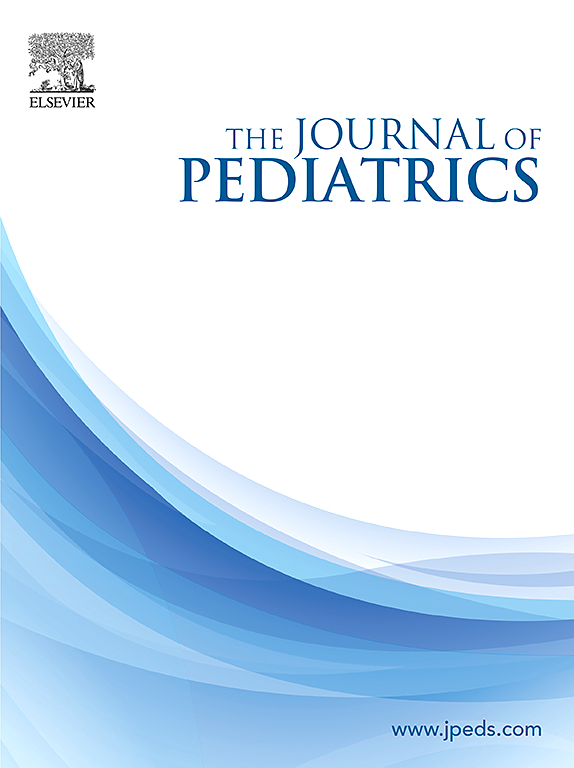Promoting Children's Active Play in Nature via Primary Care
IF 3.5
2区 医学
Q1 PEDIATRICS
引用次数: 0
Abstract
Objective
To assess the feasibility, acceptability, and utility of Project Nature (PN), an intervention during well-child checks, to promote children's active play in nature from the perspectives of parents and clinic staff.
Study design
Six primary care clinics in Washinton State implemented PN, including anticipatory guidance from a clinician, a nature-based toy, and written/internet based family resources, during well-child checks for 1-10 year olds. We conducted quantitative surveys of different groups of parents before (control group, n = 154) and after (intervention group, n = 131) the implementation of PN at each clinic. We analyzed differences between the 2 groups using chi-square and Mann–Whitney U tests. Postintervention, we conducted qualitative interviews with 11 clinic staff members about implementation, coded the data, and conducted thematic analysis.
Results
The proportion of parents reporting that their child's clinician encouraged daily outdoor time was higher postintervention than the control group (85% vs 54%, P = .02). A higher proportion of parents in the intervention compared with the control group reported that the clinician encouraged daily physical activity (86% vs 71%, P = .09). Families generally reported strong satisfaction with all the intervention components. Clinic staff felt PN facilitated conversation around active outdoor play and believed that PN was feasible within their existing workflows.
Conclusions
PN is a feasible and acceptable approach for supporting children's active play in nature via primary care clinics. These results provide a foundation for a larger evaluation assessing the impact of PN on families' physical activity and nature-based experiences.
通过初级保健促进儿童在大自然中积极玩耍。
目的:从家长和临床工作人员的角度,评估“自然项目”(PN)在幼儿健康检查(WCC)中促进儿童在自然中积极玩耍的可行性、可接受性和实用性。研究设计:华盛顿州的六个初级保健诊所实施了PN,包括临床医生的预期指导,基于自然的玩具,以及基于书面/互联网的家庭资源,在1-10岁儿童的WCCs期间。我们对各诊所实施PN前(对照组,n=154)和实施PN后(干预组,n=131)的不同组家长进行定量调查。我们使用卡方检验和Mann-Whitney U检验来分析两组之间的差异。干预后,我们对11名临床工作人员进行了关于实施情况的定性访谈,对数据进行了编码,并进行了专题分析。结果:干预后报告临床医生鼓励孩子每天户外活动的家长比例高于对照组(85% vs 54%, P=0.02)。与对照组相比,干预组中有更高比例的父母报告说临床医生鼓励孩子每天进行体育锻炼(86%对71%,P=0.09)。家庭普遍报告对所有干预成分的强烈满意度。诊所工作人员认为PN促进了围绕积极的户外游戏的对话,并相信PN在他们现有的工作流程中是可行的。结论:PN是通过初级保健诊所支持儿童在大自然中积极玩耍的一种可行和可接受的方法。这些结果为更大的评估提供了基础,评估PN对家庭身体活动和基于自然的体验的影响。
本文章由计算机程序翻译,如有差异,请以英文原文为准。
求助全文
约1分钟内获得全文
求助全文
来源期刊

Journal of Pediatrics
医学-小儿科
CiteScore
6.00
自引率
2.00%
发文量
696
审稿时长
31 days
期刊介绍:
The Journal of Pediatrics is an international peer-reviewed journal that advances pediatric research and serves as a practical guide for pediatricians who manage health and diagnose and treat disorders in infants, children, and adolescents. The Journal publishes original work based on standards of excellence and expert review. The Journal seeks to publish high quality original articles that are immediately applicable to practice (basic science, translational research, evidence-based medicine), brief clinical and laboratory case reports, medical progress, expert commentary, grand rounds, insightful editorials, “classic” physical examinations, and novel insights into clinical and academic pediatric medicine related to every aspect of child health. Published monthly since 1932, The Journal of Pediatrics continues to promote the latest developments in pediatric medicine, child health, policy, and advocacy.
Topics covered in The Journal of Pediatrics include, but are not limited to:
General Pediatrics
Pediatric Subspecialties
Adolescent Medicine
Allergy and Immunology
Cardiology
Critical Care Medicine
Developmental-Behavioral Medicine
Endocrinology
Gastroenterology
Hematology-Oncology
Infectious Diseases
Neonatal-Perinatal Medicine
Nephrology
Neurology
Emergency Medicine
Pulmonology
Rheumatology
Genetics
Ethics
Health Service Research
Pediatric Hospitalist Medicine.
 求助内容:
求助内容: 应助结果提醒方式:
应助结果提醒方式:


